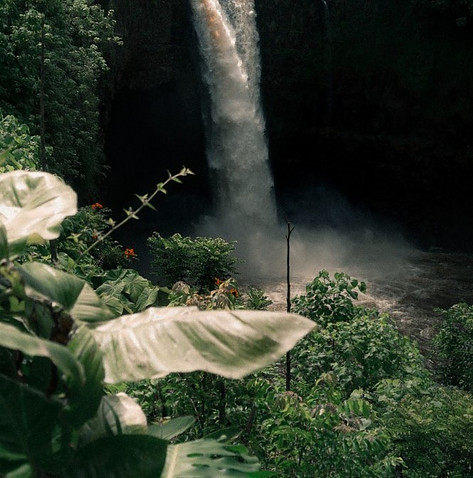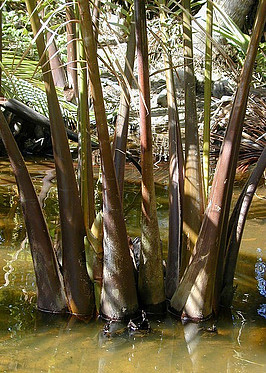
Where untouched by man (which is getting rarer and rarer these days), rain forest trees can rise to 200 ft (60 m) above the forest floor. For perspective, this is as tall as an 18-srory building. Below this layer, smaller trees produce a dense canopy so thick that very little light reaches the forest floor or the carpet of undergrowth.
Equatorial Rain Forests
Forest of this type are spread across the Equator in the Amazon and Congo basins, parts of Indonesia and several Pacific islands. The climate varies little here. Rainfall generally ranges from 60 to 138 in (1.5 – 3.5 m) and is distributed evenly throughout the calendar year. Temperatures range from 86° F (30° C) to 68° F (20°) at night.
The jungles trees rise from the roots up to the canopy, bursting into a mushroom of leaves. Because of the thickness of this canopy and cover from the smaller trees, seedlings struggle to reach light and masses of vines and lianas twine up to the sun. Ferns, mosses and herbaceous plants push through a thick, carpet of leaves and a great variety of fungi grow on leaves and fallen trunks.
It is relatively cool in this PRIMARY JUNGLE, with little undergrowth to hamper movement. However, visibility is limited to about 170 ft (50 m). It is easy to lose your sense of direction and get lost. It is also very difficult to be spotted from the air.
Secondary Jungle
In this type of jungle, growth is prolific where sunlight is allowed to penetrate all the way to the jungle floor. This generally occurs along river banks and jungle fringes and also whee PRIMARY JUNGLE has been cleared by man for slash-and-burn farming. When this land is abandoned, it is generally reclaimed by a tangled mass of vegetation over time. However, look out for cultivated food plants that may have survived among the others.
Grasses, ferns, vines and shrubs of secondary jungles can reach heights of about 7 – 10 ft (2 -3 m) in a single year alone. Moving is slow, often requiring hacking your way with a parang machete – hot, tiring work that has to be accomplished with only a few feet of visibility. Jungle vegetation can be covered with thorns and spikes and bamboo thickets can be impenetrable barriers.
Sometimes, as in the jungles in Belize, Central America, the jungle trees are low. Light does reach the ground in this environment which has the effect of producing abundant undergrowth, even in the primary jungle.
Sub-Tropical Rain Forests
These rain forests are found within 10° of the Equator, in Central and South America, Madagascar, western India, Myanmar (formerly known as Burma), Vietnam, southeast Asia and the Philippines. These particular forests have a season of reduced rainfall, even drought, with the rain coming in cycles (monsoons) vs a continuous, distributed rainfall. With more distinct seasons, there are more deciduous trees so that more light reaches the forest floor and undergrowth is dense.
Montane Forests
When altitudes reach 3300 ft (1000 m) in the tropics, as well as the areas bordering them, tropical forests begin to give way to montane (mountainous) forests. It becomes a completely montane forest at altitudes of 4100 ft (1240 m), like in such places as in the Monts Gotel in Cameroon, the Amhara Plateau of Ethiopia or the Ruwenzori Range of central Africa. The Ruwenzori – or “Mountains of the Moon” – are typical: sharply contoured slopes making a crater-like landscape covered in moss between ice-capped peaks.
Here, plant growth is sparse, trees are stunted and distorted with their branches low and difficult to walk beneath. Nights are cold, days are hot and there is a lot of mists with long periods of cloud cover. Survival is difficult in this environment – leave it and make your way back down to the tropical rain forest.
Saltwater Swamps
Where coastal areas are subject to tidal swamping, mangrove trees easily thrive. They can reach heights of 40 ft (12 m) and their tangled roots hamper travel both above and below the water. Visibility is poor and passage slow – it may take 12 hrs to cover 3000 ft (900 m). Sometimes there are channels that will permit raft passage, but more often than not, most progress will be on foot.
Mangrove swamps can be found in West Africa, Madagascar, Malaysia and the Pacific Islands, Central and South America and at the mouth of the Ganges. The swamps at the mouths of the Orinoco, Amazon and rivers of Guyana consist of a stinking mud and trees that offer little, if any, shade. Tides here can rise as much as 40 ft (12 m).
In a mangrove swamp, everything can seem hostile, from water leeches to insects, to caiman and crocodiles. Avoid these swamps if possible. If forced there by mishap or circumstance, find a way out. In spots where river channels intersect the swamp you may be able to make a raft.
However, if forced to stay in the area longer than desired, your will not starve. There is plenty of fish and vegetation. In low water, or at low tide, crabs, mollusks, catfish and mud fish can be found. Arboreal and aquatic animals include water opossum, otter, tapir, armadillo, and on firmer ground, peccaries. Interesting how such a hostile environment for man simply teems with life.
Inland of the mangroves, Nipa Palm Swamp (a.k.a. Nypa Fruticans) is common – all the palm’s growing points are edible.
 Nipa Palm Swamp (Nypa Fruticans)
Nipa Palm Swamp (Nypa Fruticans)
If forced to stay in the swamp, determine the time of high tide by finding the line of salt and debris on the trees, and set up a raised bed above it. Cover yourself for protection against ants and mosquitoes.
Freshwater Swamps
Generally found in low-lying inland areas, their mass of thorny, undergrowth, reeds, grasses and occasional short palms make travel extremely difficult and reduce visibility to only a few feet. The good news is that, just like in Mangrove swamps, wildlife abounds and survival is relatively easy. A freshwater swamp is not a bad place once your get used to it. It will often be dotted with islands and you won’t be in chest deep water (not ALL the time, anyway). There are navigable channels and plenty of raw materials available from which to build a raft.